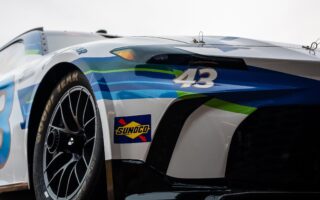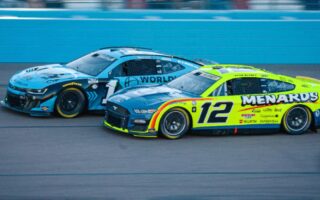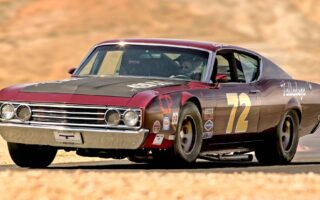In the annals of motorsport history, few names resonate as powerfully as that of Niki Lauda. The Austrian racing legend is celebrated not only for his extraordinary talent behind the wheel but also for his indomitable spirit and relentless pursuit of excellence. Among the many chapters of his illustrious career, his time with Scuderia Ferrari stands out as a defining era that encapsulated both triumph and tribulation. Lauda’s association with Ferrari was not just a partnership between a driver and a team; it was a dynamic interplay of passion, innovation, and the pursuit of speed, set against the backdrop of the fiercely competitive world of Formula 1. In this article, we delve into Niki Lauda’s remarkable journey with Ferrari, exploring how he shaped the team’s legacy and left an indelible mark on the sport itself.
Table of Contents
- Niki Laudas Impact on Ferraris Racing Legacy
- The Evolution of Ferraris Strategy Under Laudas Leadership
- Lessons from Laudas Tenacity: Resilience in Competitive Racing
- Revitalizing a Legacy: Recommendations for Modern Ferrari Management
- Q&A
- Insights and Conclusions
Niki Laudas Impact on Ferraris Racing Legacy
Niki Lauda’s association with Ferrari stands as a pivotal chapter in the storied history of the Scuderia. His remarkable driving skills and relentless dedication infused the team with a spirit of competitiveness that reignited its racing legacy. Lauda’s time at Ferrari in the mid-1970s proved crucial for the team, culminating in his first World Championship in 1975. This victory was not merely a personal achievement; it gave Ferrari a renewed sense of purpose and demonstrated their potential to dominate the sport once again.
Lauda brought both experience and a strategic mindset to Ferrari, emphasizing the importance of teamwork and technological advancement. Under his influence, the team introduced innovative solutions regarding aerodynamics and engine design that resonated well beyond Lauda’s era. His legacy can be summarized through several key contributions:
- Performance Enhancements: Pioneering aerodynamic designs that improved vehicle stability.
- Collaborative Leadership: Cultivating a team environment that encouraged open communication and shared goals.
- Tactical Insights: Influencing race strategy with a focus on precision and calculated risk-taking.
The subsequent years after Lauda’s departure saw Ferrari continue to build on the foundations he established, leading to further successes on the track. It’s no surprise that today, as we reflect on the champions who have driven the iconic red cars, Niki Lauda remains a central figure in defining what Ferrari represents—speed, elegance, and an unyielding quest for victory.
The Evolution of Ferraris Strategy Under Laudas Leadership
Niki Lauda’s tenure at Ferrari marked a transformative period for the iconic brand, showcasing his remarkable ability to marry engineering prowess with psychological mastery. His leadership style emphasized collaboration and innovation, effectively fostering a culture where engineers and drivers worked closely to optimize car performance. Lauda’s unique approach led to a series of pivotal changes within the Ferrari Formula 1 team, enhancing its competitiveness during an era marked by fierce rivalries and technological advancements. Under his guidance, Ferrari focused on:
- Driver Development: Lauda placed immense importance on nurturing talent and ensuring that drivers had a voice in the development process.
- Technical Advancements: He encouraged engineers to push boundaries, integrating cutting-edge technology to keep Ferrari at the forefront of the sport.
- Team Unity: Lauda strove to create a harmonious environment that embraced the strengths of each member of the team.
The implementation of these strategies yielded tangible results, most notably the significant improvements in car performance and team morale. A remarkable aspect of Lauda’s approach was his ability to balance his meticulous attention to detail with an innate intuition for racing dynamics. This culminated in noteworthy achievements, with Ferrari reclaiming its position as a formidable force in Formula 1. To illustrate the impact of Lauda’s leadership, consider the following table that highlights key milestones during his time at Ferrari:
| Year | Achievement | Significance |
|---|---|---|
| 1974 | First Championship Title | Marked Ferrari’s return to form |
| 1975 | Constructors’ Championship | Showcased teamwork and engineering excellence |
| 1976 | Iconic Rivalry with James Hunt | Defined Lauda’s legacy as a racer |
Lessons from Laudas Tenacity: Resilience in Competitive Racing
In the high-octane world of competitive racing, Niki Lauda’s journey with Ferrari exemplifies the power of tenacity and resilience. A driver who faced immense challenges both on and off the track, Lauda’s story is a testament to the idea that true strength lies in overcoming adversity. He famously returned to racing a mere six weeks after a life-threatening crash, showing that determination is just as important as skill, if not more so. Lauda’s unwavering focus on improvement allowed him not only to reclaim his place in the sport but also to lead his team toward victories that would forever shape Formula 1’s history.
The lessons we can draw from Lauda’s experience are as relevant today as they were during his racing career. Here are some key takeaways:
- Diligent preparation: Success in racing requires meticulous planning and practice.
- Emotional strength: Handling pressure and maintaining composure are crucial for high-performance outcomes.
- Teamwork: Collaboration with a skilled team can amplify an individual’s performance.
- Adaptability: Being open to change and learning from mistakes leads to continuous growth.
Revitalizing a Legacy: Recommendations for Modern Ferrari Management
To revitalize the legacy of Ferrari, a multifaceted approach that pays homage to its storied past while embracing modernity is essential. First and foremost, cultivating a culture of innovation should be prioritized, ensuring that Ferrari remains at the forefront of automotive excellence. This can be achieved by:
- Investing in cutting-edge technology for both performance and sustainability.
- Fostering partnerships with startups and tech firms to integrate advanced solutions.
- Enhancing the customer experience through personalized services and exclusive events.
Moreover, an increased focus on heritage branding can help maintain Ferrari’s allure, connecting with enthusiasts old and new. It’s critical to showcase legendary figures like Niki Lauda as symbols of resilience and excellence in racing. A strategic marketing campaign could highlight:
| Aspect | Strategy |
|---|---|
| Niki Lauda’s Story | Documentary series exploring his impact on Ferrari and motorsport. |
| Community Engagement | Fan events celebrating Lauda’s achievements with memorabilia showcases. |
| Digital Presence | Interactive online content bringing Lauda’s legacy to a younger audience. |
Q&A
Q&A: Niki Lauda and His Legacy with Ferrari
Q: Who was Niki Lauda?
A: Niki Lauda was an Austrian Formula One driver, known for his extraordinary talent, resilience, and dedication to the sport. He made a name for himself in the racing world during the 1970s and 1980s, becoming a three-time world champion.
Q: What was Niki Lauda’s relationship with Ferrari?
A: Niki Lauda joined Scuderia Ferrari in 1974 and quickly became a key figure in the team. His tenure was marked by impressive performances and significant victories, including winning the World Championship in 1975. Lauda’s commitment to Ferrari helped solidify the team’s position as a dominant force in Formula One.
Q: What achievements did Lauda attain while racing for Ferrari?
A: During his time with Ferrari, Lauda achieved several notable milestones. He secured the World Championship title in 1975 and played a pivotal role in the development of the Ferrari 312T, a car that became iconic in its own right. Lauda’s success helped elevate the team’s status and contributed to Ferrari’s legendary legacy in motorsport.
Q: How did Lauda’s 1976 crash affect his career with Ferrari?
A: In 1976, Lauda suffered a near-fatal crash at the Nürburgring, resulting in severe burns and injuries. Remarkably, he made a comeback just six weeks later, displaying unparalleled determination. His accident and subsequent return to racing not only highlighted his indomitable spirit but also increased his popularity and respect within the sport, further enhancing his legacy with Ferrari.
Q: What were some of Lauda’s contributions beyond driving at Ferrari?
A: Beyond his role as a driver, Lauda’s technical knowledge and involvement in car development were invaluable assets to Ferrari. His insights helped refine vehicle performance, contributing to the team’s advancements during a crucial era. Post-retirement, he also served as an advisor to the team, ensuring that his passion and expertise continued to shape Ferrari’s approaches to racing.
Q: How is Niki Lauda remembered in the context of Ferrari’s history?
A: Niki Lauda is remembered as one of Ferrari’s greatest drivers, personifying the team’s values of perseverance and excellence. His legacy is one of a true competitor who overcame adversity, bringing passion and insight to the racing team. Moreover, he is celebrated for his status as an enduring icon of the sport, inspiring generations both on and off the track.
Q: What impact did Niki Lauda have on Formula One as a whole?
A: Lauda’s impact on Formula One extends beyond his wins and championships. He challenged the status quo with his analytical approach to racing and engineering, emphasizing the importance of safety and driver welfare, particularly after his own harrowing accident. His influence is felt not only in Ferrari but across the entire sport, embodying the spirit of innovation, dedication, and resilience.
Q: Is there anything else noteworthy about Lauda’s legacy with Ferrari?
A: Lauda’s story is not only about victories but also about the human spirit. His life reflects the complexity of racing—the fierce competition, the personal sacrifices, and the sheer joy of driving. His time at Ferrari illustrates the journey of a man who was not just a racer, but a pioneer who embraced every challenge, leaving behind a legacy that continues to inspire.
Insights and Conclusions
In the annals of Formula 1 history, few partnerships resonate as profoundly as that of Niki Lauda and Ferrari. Their journey, marked by triumphs and tribulations, reflects not just the spirit of racing but the very essence of human perseverance. Lauda’s exceptional prowess behind the wheel, combined with Ferrari’s relentless pursuit of excellence, forged a legacy that transcends statistics and podium finishes. As we look back on their saga, we are reminded that the heart of motorsport lies not only in speed but in the stories of those who dare to chase it. With every lap, every challenge, and every victory shared, Lauda and Ferrari etched their names into the fabric of the sport, inspiring generations to come. As the engines quiet, their remarkable tale continues to fuel the dreams of aspiring racers, proving that the drive for greatness is a journey, not just a destination.


